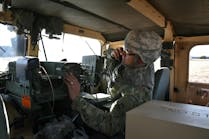Eight-channel discrete-to-digital sensor IC for avionics applications introduced by Holt
MISSION VIEJO, Calif., 17 Nov. 2014. Holt Integrated Circuits in Mission Viejo, Calif., is introducing the HI-8429 eight-channel discrete-to-digital sensor IC for avionics applications.
The HI-8429 has programmable sense channels and internal lightning protection. The sense input thresholds are programmable via a 10 MHz SPI bus and each channel may be configured individually as GND/Open or Supply/Open (28-volt/Open) sensors.
The device also has an optional debounce circuit and sensor output interrupt pin.
The HI-8429 operates from a 3.3-volt digital supply and 12-volt to 16.5-volt analog supply. The device is compliant with Airbus ABD0100H specification and has inputs individually configurable as either GND/Open or Supply/Open (28-volt/Open). Discrete input thresholds are programmable in the range of 2 to 14 volts.
In GND/Open mode a 1 milliamps wetting current is sourced from the sense input to prevent dry relay contacts. An optional debounce circuit also ensures sensor outputs respond correctly to mechanical sensor inputs. A sensor output interrupt pin alerts the system to a change in sensor input, avoiding constant polling via SPI to check status.
All sense inputs are internally lightning protected to RTCA/DO160G, Section 22 Level 3 Pin Injection Test Waveform Set A (3 & 4), Set B (3 & 5A) and Set Z (3 & 5B) without the use of any external components. Higher levels of lightning protection can be achieved with an external series resistor and transorb at each sense input.
The device is available in a 20-pin, wide-body SOIC with exposed heat pad. Samples are available on request. Holt also provides a development kit with example software and source code.
For more information contact Holt Integrated Circuits online at www.holtic.com.

John Keller | Editor
John Keller is editor-in-chief of Military & Aerospace Electronics magazine, which provides extensive coverage and analysis of enabling electronic and optoelectronic technologies in military, space, and commercial aviation applications. A member of the Military & Aerospace Electronics staff since the magazine's founding in 1989, Mr. Keller took over as chief editor in 1995.



